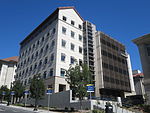The UC Berkeley College of Chemistry is one of 14 schools and colleges at the University of California, Berkeley. It houses the departments of Chemistry, Chemical and Biomolecular Engineering, and Chemical Biology and occupies six buildings flanking a central plaza.UC Berkeley's College of Chemistry has been listed as the best global university for chemistry in the 2020 U.S. News and World Report Education rankings. The college's Chemical and Biomolecular Engineering program was ranked number two in a tie with Caltech among U.S. News Best Chemical Engineering Graduate Programs in the United States in 2021. Its faculty and graduates have won numerous awards, including the Wolf Prize, the National Medal of Science, the National Medal of Technology, the Presidential Medal of Freedom, as well as fifteen Nobel Prizes.The Department of Chemistry is one of the largest and most productive in the world, graduating an average of 80 doctoral students per year. As of July 2020, the College hosts 48 recognized world-class researchers by production of multiple highly cited papers that rank in the top 1% by citations for field and year in Web of Science. Scientists affiliated with the department and the nearby Lawrence Berkeley National Laboratory are responsible for the discovery of sixteen elements, including berkelium, named after the city, and seaborgium, named after Nobel laureate and former department chair Glenn Seaborg.First established in 1872, the college awarded its first Ph.D. in 1885 to John Maxson Stillman, who later founded the chemistry department at Stanford University. A Division of Chemical Engineering was established in 1946, becoming a department in 1957. The Department of Chemical Engineering changed its name to Chemical and Biomolecular Engineering in 2010 to reflect the research focus of its faculty in the 21st century. The College will turn 150 in 2022.









